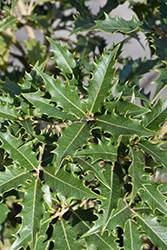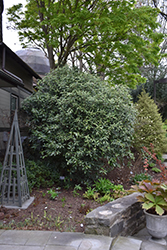Fri & Sat 8am - 8pm
Sun 8am - 7pm
Anytown, USA 12345
fax: 261.787.0463
e-mail: info@successgc.com


Plant Finder

Height: 15 feet
Spread: 10 feet
Sunlight:
![]()
![]()
Hardiness Zone: 7a
Other Names: False Holly, Holly Olive, Devilwood
Description:
A dense, upright evergreen shrub or small tree, with spiny, lustrous, deep green leaves that are holly-like; fragrant, tiny white flowers in axillary clusters appear in early fall; forms an excellent screen or hedge, great for shrub borders
Ornamental Features
Devil Wood is covered in stunning clusters of fragrant white tubular flowers along the branches from late summer to early fall. It has attractive dark green foliage with pointy light green spines. The spiny narrow leaves are highly ornamental and remain dark green throughout the winter. The smooth gray bark is extremely showy and adds significant winter interest.
Landscape Attributes
Devil Wood is a dense multi-stemmed evergreen shrub with a shapely oval form. Its average texture blends into the landscape, but can be balanced by one or two finer or coarser trees or shrubs for an effective composition.
This is a relatively low maintenance shrub, and should only be pruned after flowering to avoid removing any of the current season's flowers. It is a good choice for attracting bees and butterflies to your yard, but is not particularly attractive to deer who tend to leave it alone in favor of tastier treats. Gardeners should be aware of the following characteristic(s) that may warrant special consideration;
- Spiny
Devil Wood is recommended for the following landscape applications;
- Accent
- Mass Planting
- Hedges/Screening
- General Garden Use
- Topiary
- Container Planting
Planting & Growing
Devil Wood will grow to be about 15 feet tall at maturity, with a spread of 10 feet. It has a low canopy with a typical clearance of 1 foot from the ground, and is suitable for planting under power lines. It grows at a slow rate, and under ideal conditions can be expected to live for 40 years or more.
This shrub does best in full sun to partial shade. You may want to keep it away from hot, dry locations that receive direct afternoon sun or which get reflected sunlight, such as against the south side of a white wall. It does best in average to evenly moist conditions, but will not tolerate standing water. This plant should not require much in the way of fertilizing once established, although it may appreciate a shot of general-purpose fertilizer from time to time early in the growing season. It is particular about its soil conditions, with a strong preference for rich, acidic soils. It is highly tolerant of urban pollution and will even thrive in inner city environments. This species is not originally from North America.
Devil Wood makes a fine choice for the outdoor landscape, but it is also well-suited for use in outdoor pots and containers. Because of its height, it is often used as a 'thriller' in the 'spiller-thriller-filler' container combination; plant it near the center of the pot, surrounded by smaller plants and those that spill over the edges. It is even sizeable enough that it can be grown alone in a suitable container. Note that when grown in a container, it may not perform exactly as indicated on the tag - this is to be expected. Also note that when growing plants in outdoor containers and baskets, they may require more frequent waterings than they would in the yard or garden.

